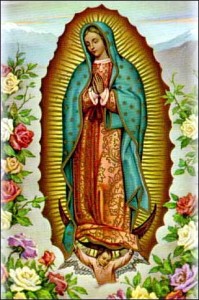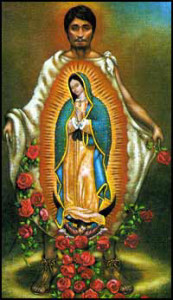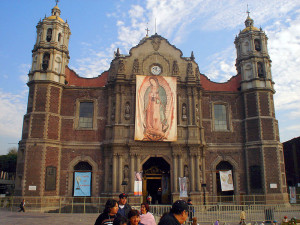When deciding what topic I wanted to research for our final project, I had noticed a constant commonality in the books we were reading, specifically in the Mexican culture of each character. The Lady of Guadalupe, also known as the Virgin of Guadalupe, is the patron saint of Mexico and an iconic symbol of Mexican Culture. In this first part of three, I will be delving into the history of the “La Reina de Mexico” to understand why in the future, her symbol is one that the Chicano Movement that began in the 1940s and was reestablished in the 1960s, as well as the other minority groups of counterculture used as a representation of their past struggles and future motivations.
Prior to the appearance of the Virgin to Mexico, the Ancient Aztecs were practicing the Mesoamerican religion of worshipping the Divine. They practiced festivals and rituals of several deities until they were conquered by the Spanish Conquistadors, led by Hernando Cortes, in 1519. The ending result transformed their religious belief system into Christianity but an interesting note was the encouragement by the Catholic Churches to worship patron saints as a way to make the transition from Aztec belief systems smoother for the people:
“Worship of the Virgin Mary was encouraged through a variety of manifestations, such as the Virgin of Remedios and the Immaculate Conception. After the conquest, the church destroyed shrines to indigenous gods and goddesses, and tried to stamp out the cult of Tonantzin, an Aztec virgin deity. Since manifestations of the Virgin had encouraged the conquistadors, many images of the Virgin Mary had made their way to the New World. Indians, mestizos, and criollos lent new meanings to the cult of the Virgin Mary. The devotion to the Virgin of Guadalupe is a syncretic manifestation of Catholic and Aztec beliefs” (Mueller).
The first account of the Virgin of Guadalupe appeared with a glowing light around her to a peasant in a vision in the border of Mexico City in the hills of Tepeyac. The peasant’s name was Juan Diego and the vision occurred in 1531. The importance of the event is that Juan Diego was an indigenous man and the Virgin of Guadalupe was descried as having “dark skin and the fact that the story of her apparition was told in the indigenous language of Nahuatl” (“Everything You Need to Know”). The language of Nahuatl belongs to the ancient Aztecs. She wanted him to build a shrine of her on the hill of the vision, Tepeyac. Juan Diego took this message back to the Archbishop, who had reservations about the entire event and demanded a sign from the Virgin as a way to show him she was legitimate. Juan Diego explained this to the Virgin when she appeared to him again. She ordered him to collect Castilian roses around the hill and she helped him arrange them into his cloak. When he returned back to this village, he opened his cloak to a miracle:
“When he arrived on December 12 and opened his tilmátli in front of the archbishop, the image of the Virgin of Guadalupe had been imprinted on the tilmátli. The tilmátli with the imprint is still on display at the Basilica de Guadalupe, one of the most visited shrines in the world” (La Virgen de Guadalupe [History]).
The archbishop decided to honor her request to build a temple, the Basilica de Guadalupe in Tepeyac to pay homage to La Virgen. This basilica houses the world’s most-visited Catholic shrine. In fact, the sacred Juan Diego cloak with the image of the Virgin of Guadalupe was on display for the many visitors from 1709-1974. The original Basilica de Guadalupe was constructed from 1531-1750 and began as a series of shrines. In 1904, the building was granted basilica status by Pope Pius X. With the ground sinking underneath the old building, a new Basilica was constructed by Mexican architect Pedro Ramirez Vazquez. In it’s new construction, Vazquez created a circular shape to allow visibility of the image of the Virgin to the masses of people who visit the sanctuary (Latinitas). Below, on the left is a picture of the old Basilica and on the right is the newly constructed Bascilica:
With the story of La Virgen, especially in connection to the Chicano Movement of the 1960s, I find it incredibly important to mention the account of her physical attributes:
“The appearance of the Virgin of Guadalupe to an indigenous man is said to be one of the forces behind creating the Mexico that we know today: a blend of Spanish and native blood. Her dark skin and the fact that the story of her apparition was told in the indigenous language of Nahuatl and in Spanish are said to have helped convert the indigenous people of Mexico to Christianity at the time of the conquest. She is seen as having a blend of Aztec and Spanish heritage” (Everything You Need to Know).
This description of her is the perfect introduction into the second part of my examination of the importance of her image to the Chicano Movement. In the next part, I will be dissecting in images as well as accounts of why Chicanos/Chicanas used the Lady of Guadalupe as a symbol of their connection to the world. She represents a symbol of identity and nationalism to the Chicano people.
Works Cited:
Mueller, RoseAnna. “Virgen de Guadalupe”. La Virgen de Guadalupe. N. d. Web. 2 April. 2014. <http://www.blueroadrunner.com/virgen.htm>
N. a. “Everything You Need to Know About the La Virgen de Guadalupe”. Latino Voices. Huffington Post. 12 Dec. 2013. Web. 2 April 2014. <http://www.huffingtonpost.com/2013/12/12/virgen-de-guadalupe_n_4434582.html>
N. a. “Our Lady of Guadalupe: Patroness of the Americas”. Guadalupe: Our Lady of Guadalupe. Sancta.org. Web. 2 April 2014. <http://www.sancta.org/intro.html>
N. a. “La Virgen de Guadalupe [History]. La Virgen de Guadalupe [History]. Latin Bay Area. N.d. Web. 2 April 2014.<http://www.latinbayarea.com/article/la-virgen-de-guadalupe-history>
Images:
http://www.latinbayarea.com/article/la-virgen-de-guadalupe-history
http://www.liturgies.net/saints/mary/guadalupe/prayers.htm
http://www.drstandley.com/saints_stjuandiego.shtml
http://en.wikipedia.org/wiki/Juan_Diego
http://en.wikipedia.org/wiki/Basilica_of_Our_Lady_of_Guadalupe
Video:







I am glad someone decided to examine the role of this quintessential figure of Latin American religiosity. Growing up catholic, I witnessed the fervent adoration people feel and teach to young children towards the virgin and her many apparitions. The chapel I visited while I was still religious belonged to a dioceses named after Guadalupe and the education I received there was heavily concentrated in understanding and consequently worshipping this maternal figure. In my experience, the Virgin Mary seems to inspire a more emotional connection than Jesus, especially in Latin American congregations. This devotion to Guadalupe is evident in the epithets she was given by Pope John Paul II: “”Patroness of the Americas” and “Empress of Latin America”— as you stated, the plays a pivotal role in Latin American culture and identity, particularly Mexican nationalism.
In general terms, I think the Virgin’s popularity can be obviously attributed to her maternal quality, since not only is she the pure vessel through which the savior comes to our ‘sinful’ world, but also she remains a figure of clemency who advocates for salvation and intercedes with God for the fateful like a mother protecting her children. Moreover, I think there’s definitely a correlation between the cult of the Virgin and the pre-colonial spirituality of the native people who were Christianized; many forced converts probably saw the mother of Jesus as a continuation of their female deities and thus, her presence in this foreign dogma helped the transition into a new spiritual realm. The virgin of Guadalupe is a fascinating figure because she relates even more deeply to this aboriginal heritage. She gives a space in Christianity to the voiceless, marginalized natives and appears as one of them, in a symbolic gesture of equality and legitimization of this people as important members of Christendom.
I really like the way the history of the Virgin of Guadalupe is traced back to its earliest events. I particularly found the quote stating how “The appearance of the Virgin of Guadalupe to an indigenous man is said to be one of the forces behind creating the Mexico that we know today: a blend of Spanish and native blood.” This familiarity that was created through her looking like the people, speaking their native and conquers tongue, created a bonding and embracing relationship between the people and their roots. She offered the people hope, inspiration and a connection to something larger than their mundane tasks. Through this the Mexican people were able to revere her and ask her for help becoming the patron saint of the Americas.
Conversion of native of people is always very interesting, in my mind.In the Scandinavian countries, many of the Catholic conceits such as resurrection and the significance of the winter solstice were actually a challenge to what were then Pagan beliefs. I bring this analog up because the Virgin of Guadalupe truly is curious to me not so much due to her miraculous underpinnings, but insofar as her apparition embodies a successful conversion method utilized by the Catholic Church to empathize with natives. On the contrary, Catholics through the Middle Ages had a difficulty converting many Pagans as the similarities of their gods made Pagans in many respects skeptical to the claims of Catholicism.
Furthermore, I think this write-up exhibits a great deal of research, not the least of which being the noting of the Virgin apparition’s dark skin and indigenous language influencing the region’s perception of their Spanish conquerors. This leads me to ask if for all the gunpowder, steel and germ warfare of the Spanish, could the most significant asset to their conquest of New Spain, in fact, have been an apparition?
Thank you for sharing the history behind La Virgen de Guadalupe. I was always curious as to why certain countries had specific “virgins” assigned to them. The historical background of how she came to hold the importance which she has in Mexico explains so much. The Virgen was obviously not just simply another saint for the indigenous people of Mexico, but someone they could relate to and see themselves in. Seeing a holy figure which represented, both literally and spiritually, the people of Mexico seems like the perfect way to get the Aztecs to convert to Christianity. Furthermore, it alleviates fear of the white person, Spaniard in this case, by showcasing a positive image.